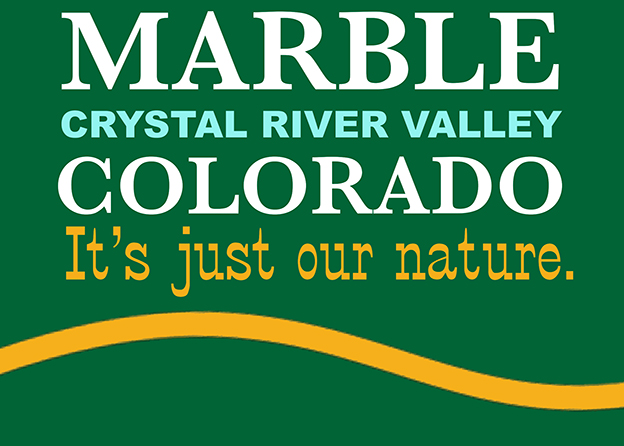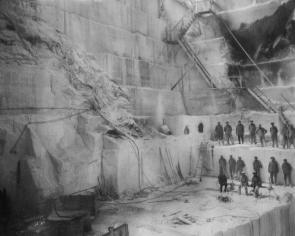History

“BE IT THE STONE OR THE TOWN”
Marble, Colorado is a sleepy little town tucked away in the Rocky Mountains. Itʼs just over a mountain—but a world away—from Aspen. Today it has a population of about 100 people, but in the early part of the 20th century, with a population in the thousands, it played a major role in the architecture and monuments in America. Marble, the stone, was discovered by prospectors in the 1870s, who were looking for silver and gold. But the actual saga started a few hundred million years earlier.
Marble (stone) is metamorphosed limestone and, as such, only occurs where there was once a sea bed. In the case of Yule Marble the limestone is the Mississippian Leadville Limestone formation which was once an ocean floor. Over the course of about 100,000,000 years the skeletons of the critters that lived in the sea (probably mostly plankton) settled to the bottom and eventually formed a layer of limestone about 300 feet thick and many miles long and wide. But it’s what happened in the next 100 million years that turned the limestone into marble and really caused the Town of Marble to come about thousands of years later. The layer of limestone was thrust up several thousand feet and also covered up by volcanic activity. This “pressure cooked” the limestone at about 435°C (815°F) causing the calcium carbonate to be recrystallized into marble, and driving off most of the impurities. For a complete explanation of this metamorphic process, see the paper by Everett & Hoisch referenced below.
The Town of Marble was incorporated in 1899, and the marble industry grew slowly because the marble was difficult to extract and transporting it was a longstanding challenge. Shown here is the main chamber of the Yule Quarry, circa 1920s, where all the blocks for the Lincoln Memorial were quarried and sent to the finishing mill.
But the Colorado-Yule Quarry did become successful and a tram was built to bring the marble down the mountain to the Treasury Mountain Railway, by which this beautiful white stone was transported to Carbondale and introduced throughout the country. The Colorado-Yule Marble Company also built the largest marble finishing mill in the world, the length of 5 ½ football fields, complete with an overhead crane system to take the pieces to the various shops for fabrication.
Countless buildings and monuments throughout the United States were built with marble from Marble, Colorado, and the population continued to increase, to a high of about 1400 in the boom years of 1912-1917. In 1913, a slab of Yule marble was sent to Washington, D.C. to be part of the Washington Monument. On March 10, 1914, the Colorado-Yule quarry was awarded its most prestigious contract to date: the Lincoln Memorial in Washington, D.C., designed by Henry Bacon. His inspiration was the Parthenon in Athens, Greece, the birthplace of democracy, a fitting tribute to President Lincoln, who kept our American democratic experiment intact. World War I dealt a devastating blow to the Marble economy because many of the workers in Marble were from Austria and Italy, and returned to their European homelands to fight in the war. The Colorado-Yule Marble Company closed the quarry and the finishing mill in 1917. By 1920, Marble had a population of only 81.
In 1930, however, the Yule-Colorado company was awarded the most prestigious marble contract of the time—that of the block for the Tomb of the Unknown Soldier. After two failed attempts to quarry a “perfect” block the third try succeeded. This was, at the time, the largest block of marble ever quarried in the world. It then took workers another 4 days to get this 56 ton block of marble down the mountain. The block was loaded onto a rail car and shipped to Vermont for cutting and then to Arlington Cemetery for carving, where it still resides today.
The Yule Marble quarry closed in 1941 as a result of declining demand and the entry of the United States into WWII. Much of the equipment and railroad was scrapped and used in the war effort. The population of Marble continued to decline…down to a population of 1 in the 1950s (schoolteacher Teresa Herman). But the beautiful valley did not remain a ghost town for long, attracting tourists, retirees and even a failed ski area development in the late 1960s and early 1970s. In 1990 the quarry was reopened.
The story of Marble is closely connected to the marble quarry and finishing mill. A large part of that story is the far-sightedness and determination of those who pursued their dream and produced some of the most beautiful and meaningful monuments in the country that stand as an inspiration to all of us.
MARBLE MUSEUM IS OPEN:
THURSDAY – SUNDAY, 11AM -4PM
ADMISSION = $5.00 ADULTS
“BE IT THE STONE OR THE TOWN”
Marble, Colorado is a sleepy little town tucked away in the Rocky Mountains. Itʼs just over a mountain—but a world away—from Aspen. Today it has a population of about 100 people, but in the early part of the 20th century, with a population in the thousands, it played a major role in the architecture and monuments in America. Marble, the stone, was discovered by prospectors in the 1870s, who were looking for silver and gold. But the actual saga started a few hundred million years earlier.
Marble (stone) is metamorphosed limestone and, as such, only occurs where there was once a sea bed. In the case of Yule Marble the limestone is the Mississippian Leadville Limestone formation which was once an ocean floor. Over the course of about 100,000,000 years the skeletons of the critters that lived in the sea (probably mostly plankton) settled to the bottom and eventually formed a layer of limestone about 300 feet thick and many miles long and wide. But it’s what happened in the next 100 million years that turned the limestone into marble and really caused the Town of Marble to come about thousands of years later. The layer of limestone was thrust up several thousand feet and also covered up by volcanic activity. This “pressure cooked” the limestone at about 435°C (815°F) causing the calcium carbonate to be recrystallized into marble, and driving off most of the impurities. For a complete explanation of this metamorphic process, see the paper by Everett & Hoisch referenced below.
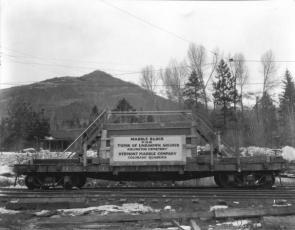
The Town of Marble was incorporated in 1899, and the marble industry grew slowly because the marble was difficult to extract and transporting it was a longstanding challenge. Shown here is the main chamber of the Yule Quarry, circa 1920s, where all the blocks for the Lincoln Memorial were quarried and sent to the finishing mill.
But the Colorado-Yule Quarry did become successful and a tram was built to bring the marble down the mountain to the Treasury Mountain Railway, by which this beautiful white stone was transported to Carbondale and introduced throughout the country. The Colorado-Yule Marble Company also built the largest marble finishing mill in the world, the length of 5 ½ football fields, complete with an overhead crane system to take the pieces to the various shops for fabrication.
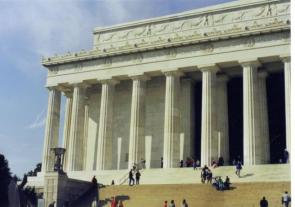
Countless buildings and monuments throughout the United States were built with marble from Marble, Colorado, and the population continued to increase, to a high of about 1400 in the boom years of 1912-1917. In 1913, a slab of Yule marble was sent to Washington, D.C. to be part of the Washington Monument. On March 10, 1914, the Colorado-Yule quarry was awarded its most prestigious contract to date: the Lincoln Memorial in Washington, D.C., designed by Henry Bacon. His inspiration was the Parthenon in Athens, Greece, the birthplace of democracy, a fitting tribute to President Lincoln, who kept our American democratic experiment intact. World War I dealt a devastating blow to the Marble economy because many of the workers in Marble were from Austria and Italy, and returned to their European homelands to fight in the war. The Colorado-Yule Marble Company closed the quarry and the finishing mill in 1917. By 1920, Marble had a population of only 81.
In 1930, however, the Yule-Colorado company was awarded the most prestigious marble contract of the time—that of the block for the Tomb of the Unknown Soldier. After two failed attempts to quarry a “perfect” block the third try succeeded. This was, at the time, the largest block of marble ever quarried in the world. It then took workers another 4 days to get this 56 ton block of marble down the mountain. The block was loaded onto a rail car and shipped to Vermont for cutting and then to Arlington Cemetery for carving, where it still resides today.
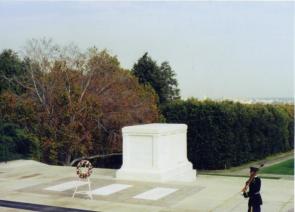
The Yule Marble quarry closed in 1941 as a result of declining demand and the entry of the United States into WWII. Much of the equipment and railroad was scrapped and used in the war effort. The population of Marble continued to decline…down to a population of 1 in the 1950s (schoolteacher Teresa Herman). But the beautiful valley did not remain a ghost town for long, attracting tourists, retirees and even a failed ski area development in the late 1960s and early 1970s. In 1990 the quarry was reopened.
The story of Marble is closely connected to the marble quarry and finishing mill. A large part of that story is the far-sightedness and determination of those who pursued their dream and produced some of the most beautiful and meaningful monuments in the country that stand as an inspiration to all of us.
MARBLE MUSEUM IS OPEN:
THURSDAY – SUNDAY, 11AM -4PM
ADMISSION = $5.00 ADULTS
Partial List of Yule Marble Buildings
| Arizona: | Mojave County Courthouse – Kingman |
| California: | Citizen’s National Bank and Merchants National Bank РLos Angeles |
| City Hall and St. Francis Hotel-San Francisco | |
| Colorado: | Court House, State Capitol Building, City and County Building, Cheeseman |
| Memorial, Union Station, Post Office – Denver | |
| Denver International Airport (Marble Wall) | |
| Idaho: | Post Office – Pocatello |
| Illinois: | Telephone Building and Rosehill Mausoleum-Chicago |
| Indiana: | Citizen’s National Bank-Evansville |
| Iowa: | Lind Mausoleum-Plover |
| Kansas: | Court House Post Office-Independence |
| Louisiana: | Commercial National Bank-Shreveport |
| Massachusetts: | Wiedener Memorial-Cambridge |
| Missouri: | Chambers Office Building-Kansas City |
| German-American Institute-St. Louis | |
| Mormon Auditorium-Independence | |
| Montana: | Montana Power House-Billings |
| State Capitol Building-Helena | |
| Nebraska: | Union Pacific Building, Douglas County Court House and Woodman of |
| The World Building-Omaha | |
| New York: | Equitable Building and Metropolitan Museum of Art-New York City |
| Ohio: | City Hall and Cuyahoga County Court House-Cleveland |
| Oklahoma: | Tulsa High School and Tulsa County Court House-Tulsa |
| Oregon: | First National Bank-Portland |
| Rhode Island: | Providence County Court House-Providence |
| South Dakota: | Court House-Aberdeen |
| Tennessee: | Commercial Trust and Savings Bank-Memphis |
| Texas: | Union National Bank and Southern Pacific Building-Houston |
| Utah: | State Capitol Building and Union Station-Salt Lake City |
| Washington: | Union Bank-Seattle |
| Washington DC: | Lincoln Memorial, Washington Monument, Tomb of the unknown Soldier |
| Wyoming: | Bank Building-Sheridan |
For more information contact The Crystal River Heritage Association.
